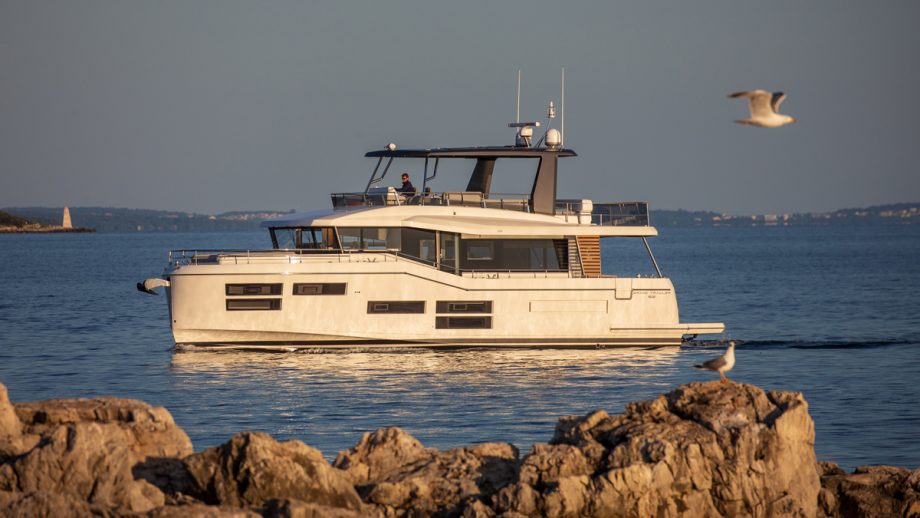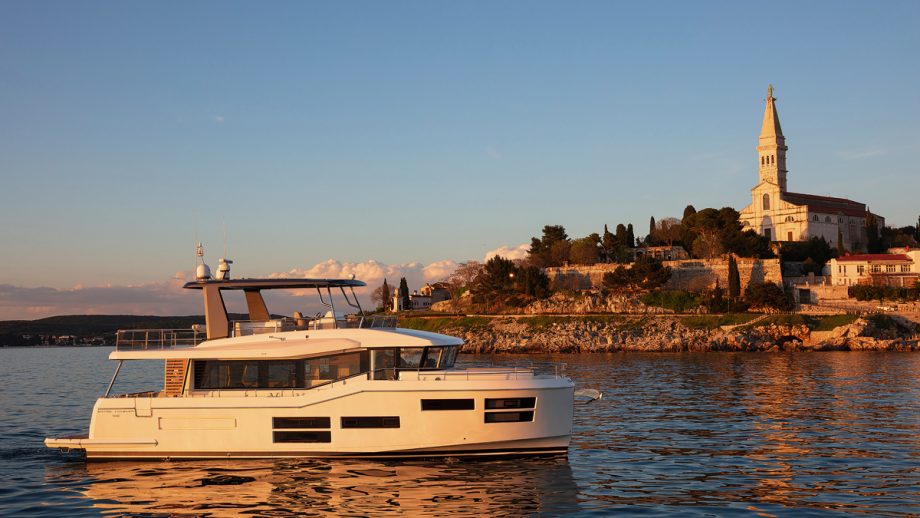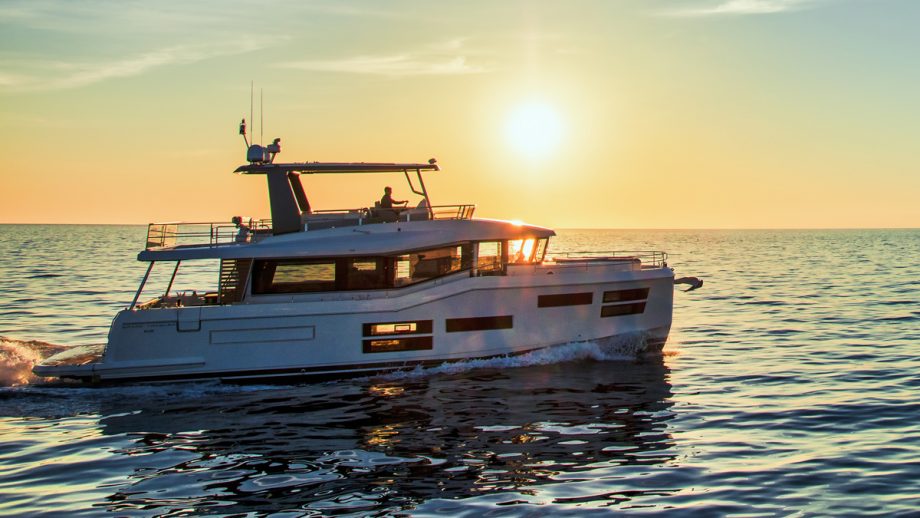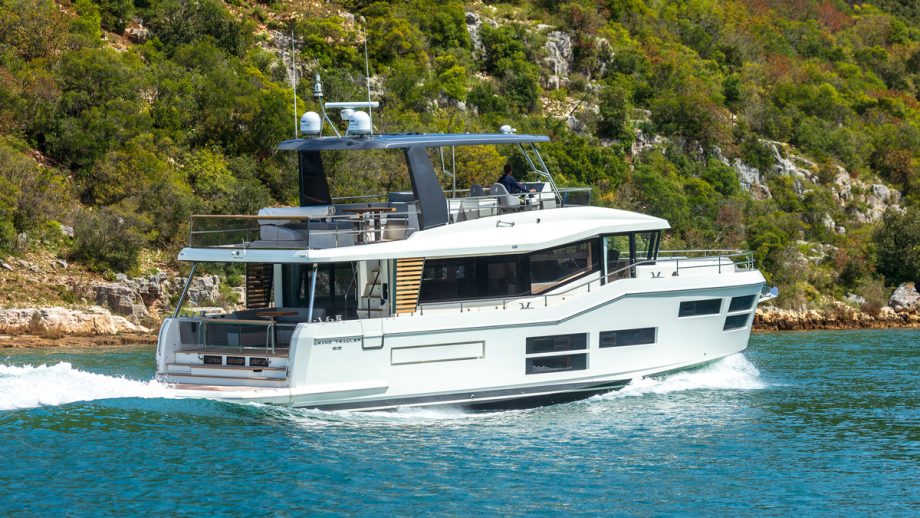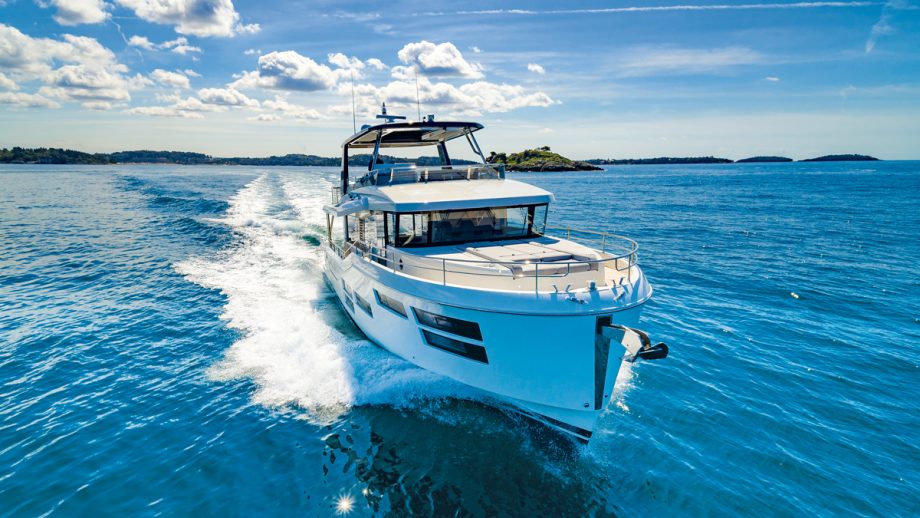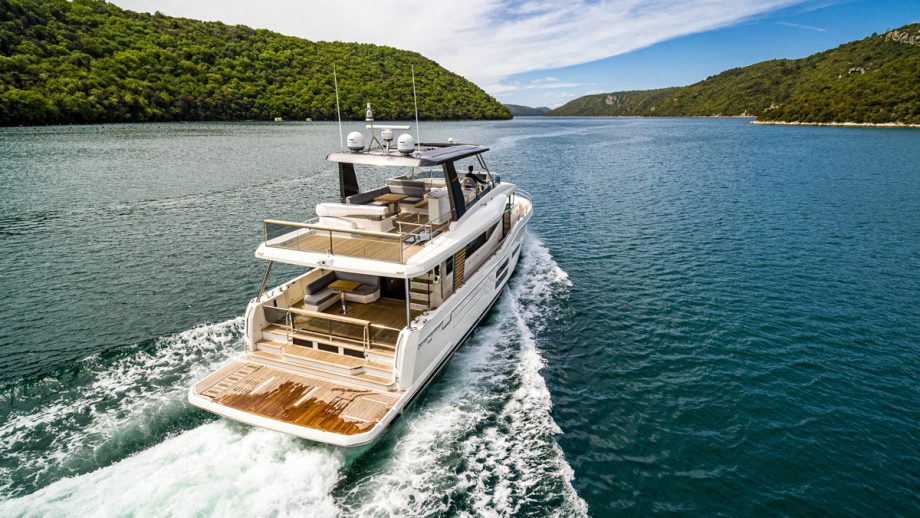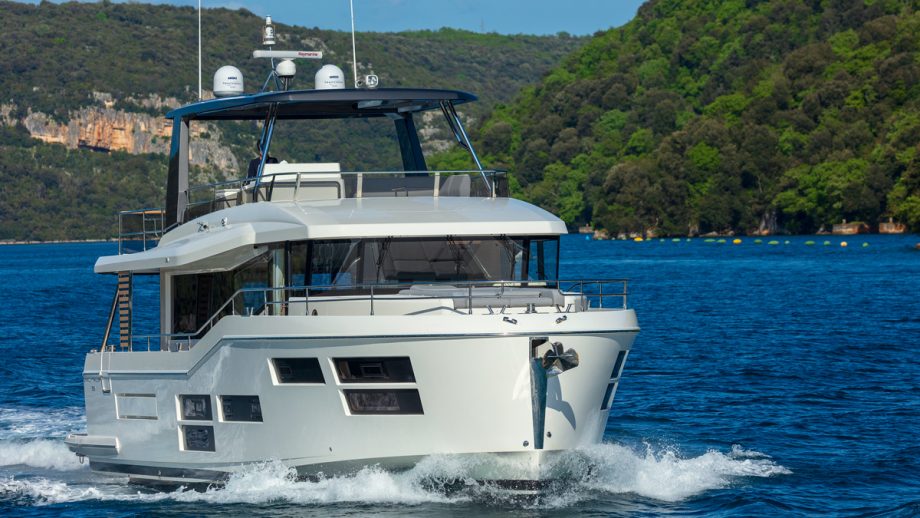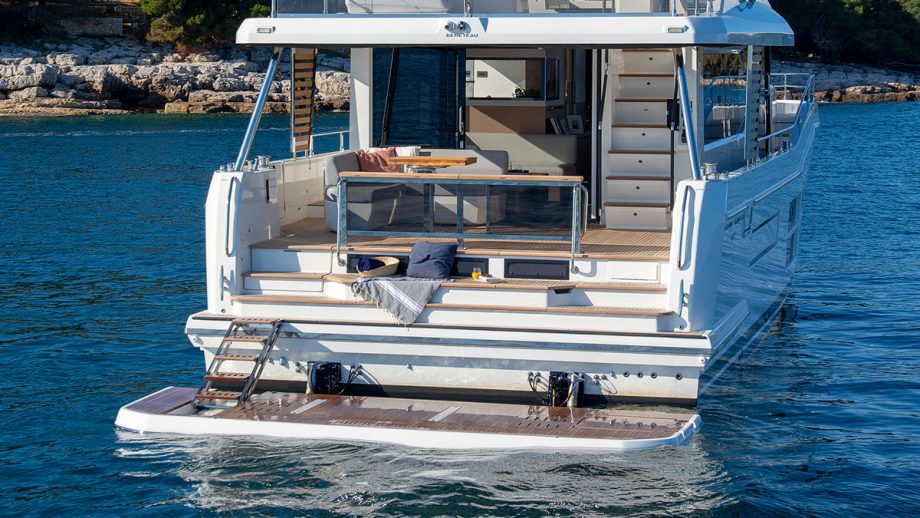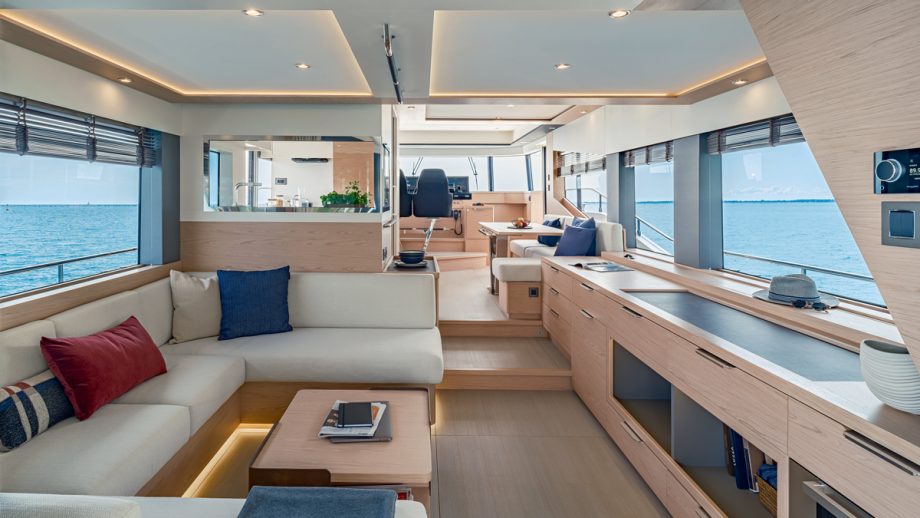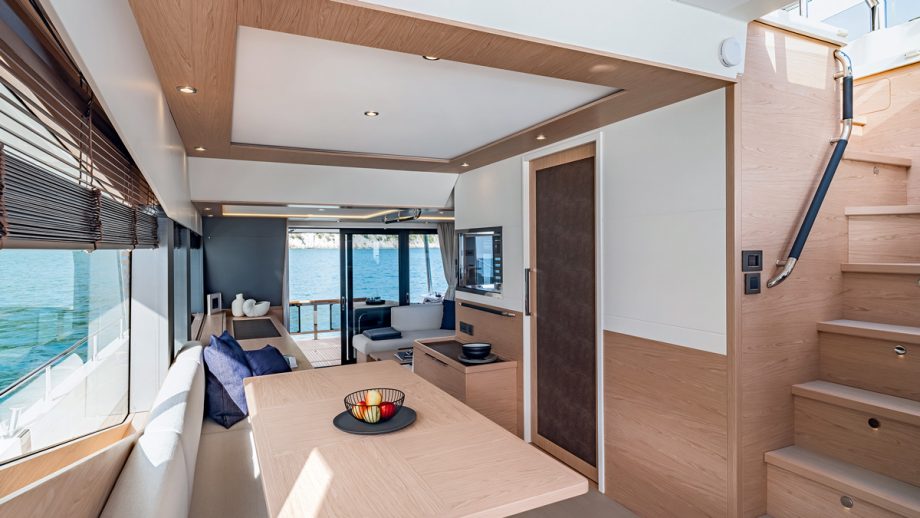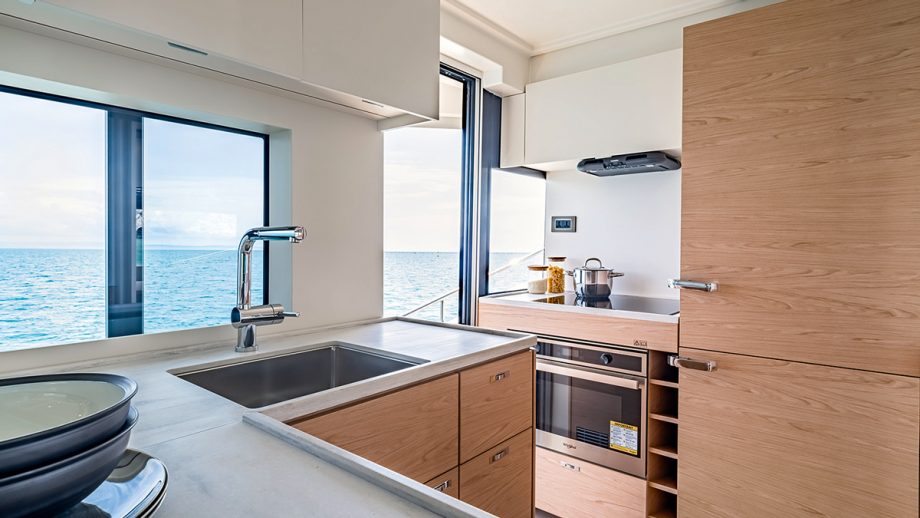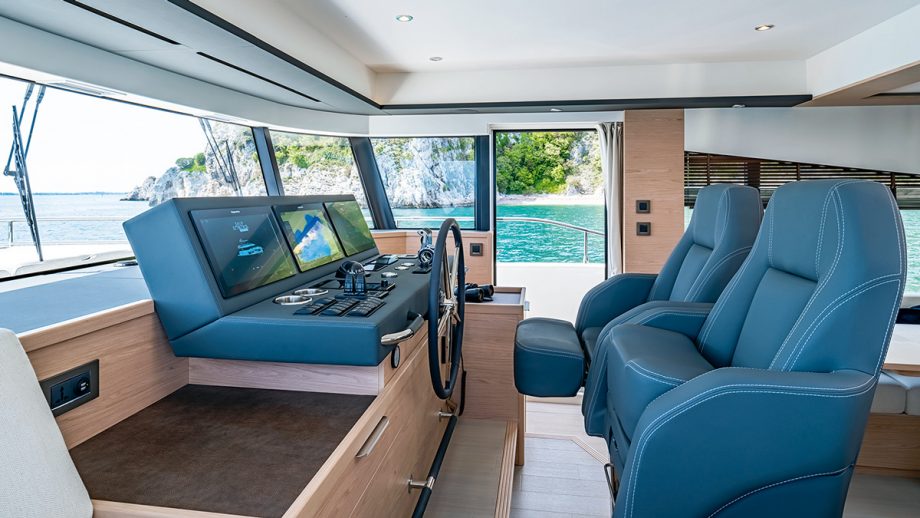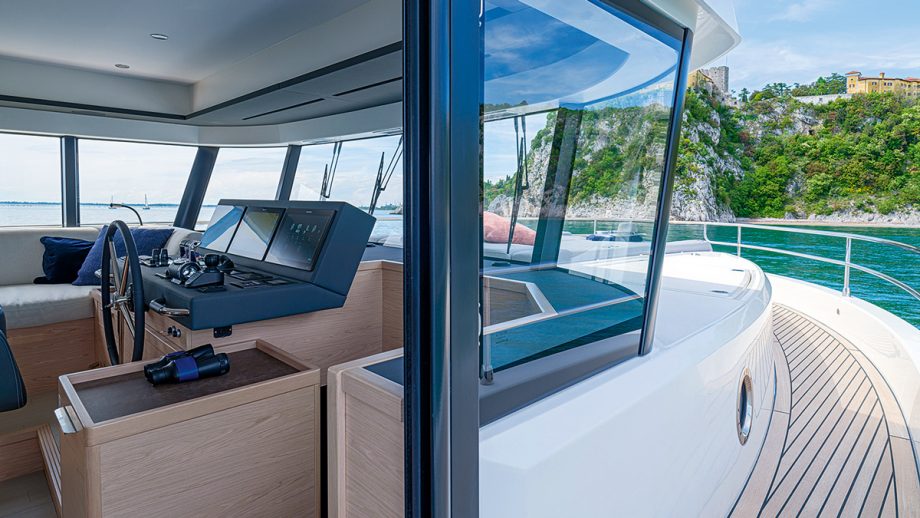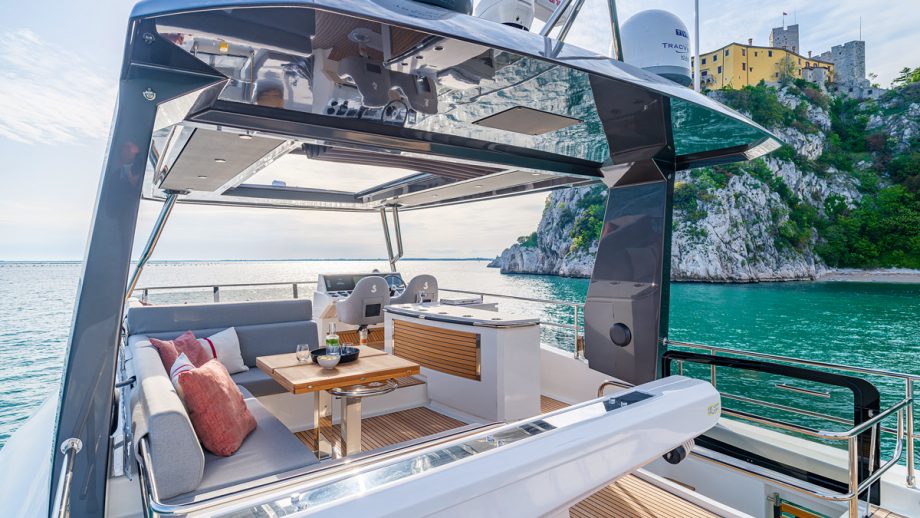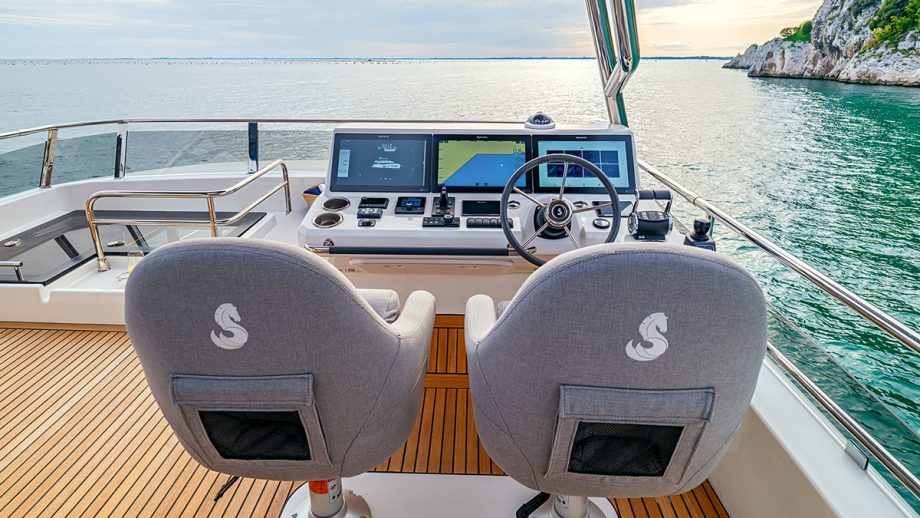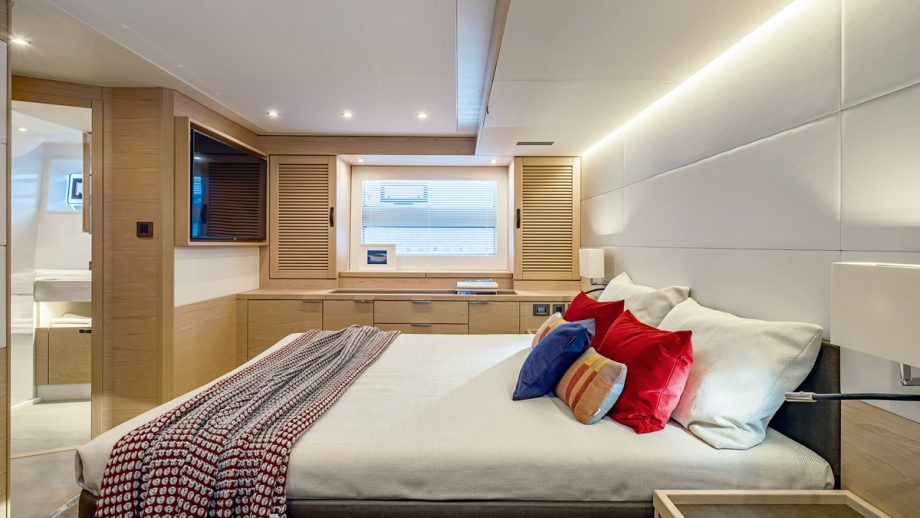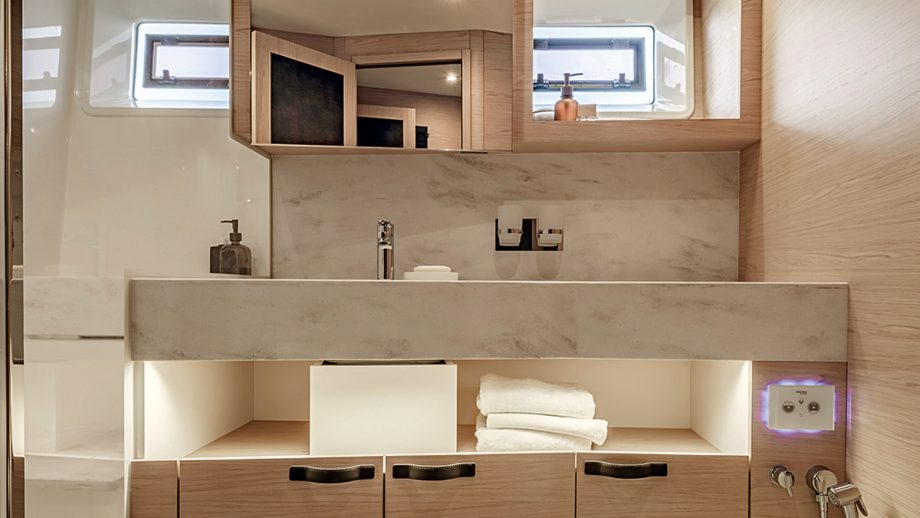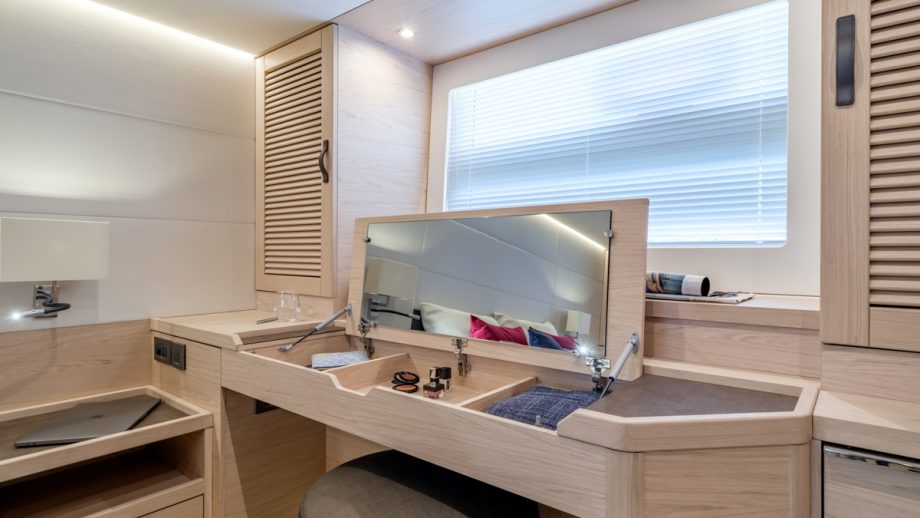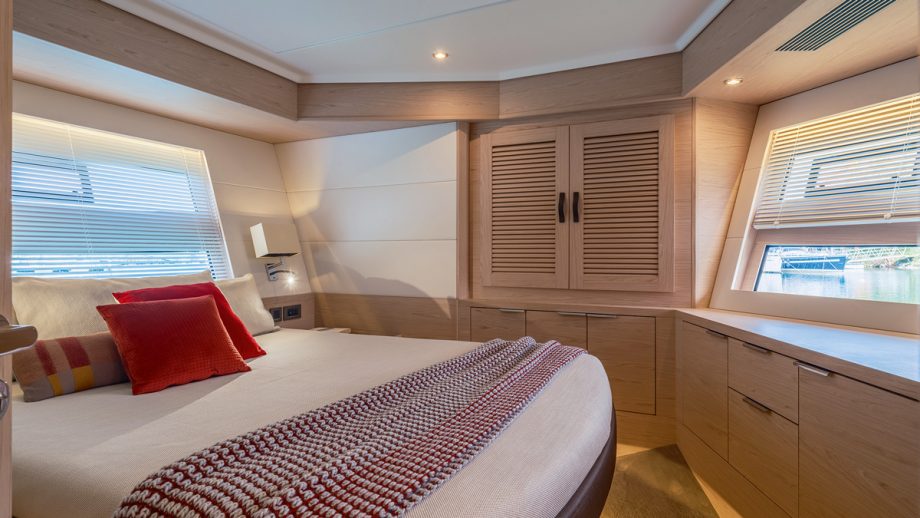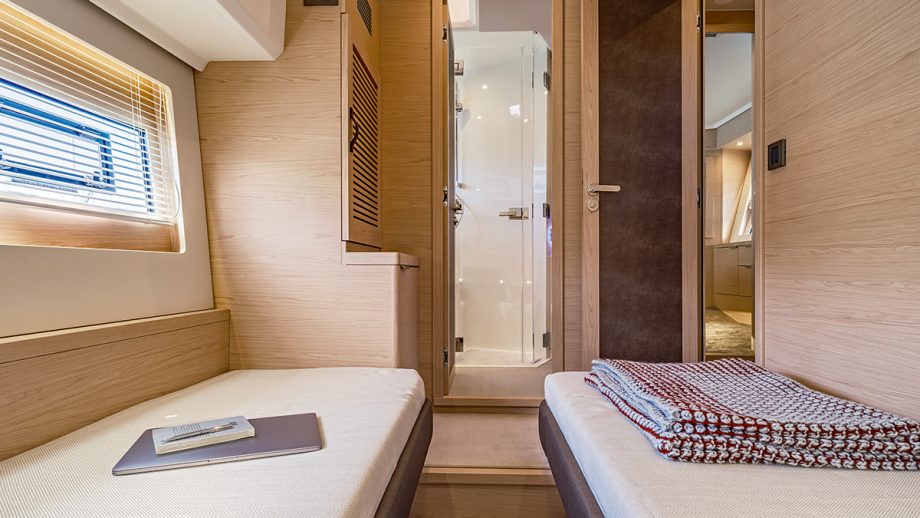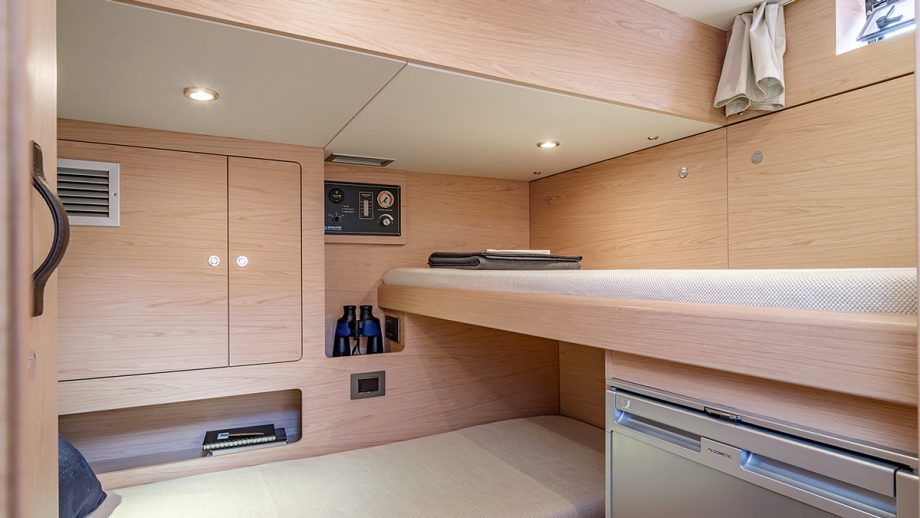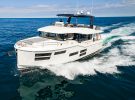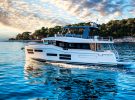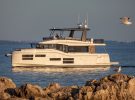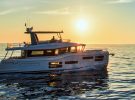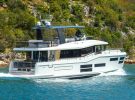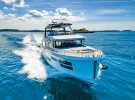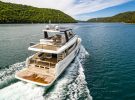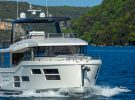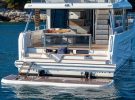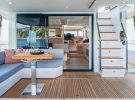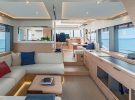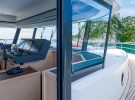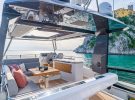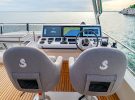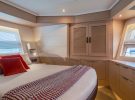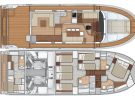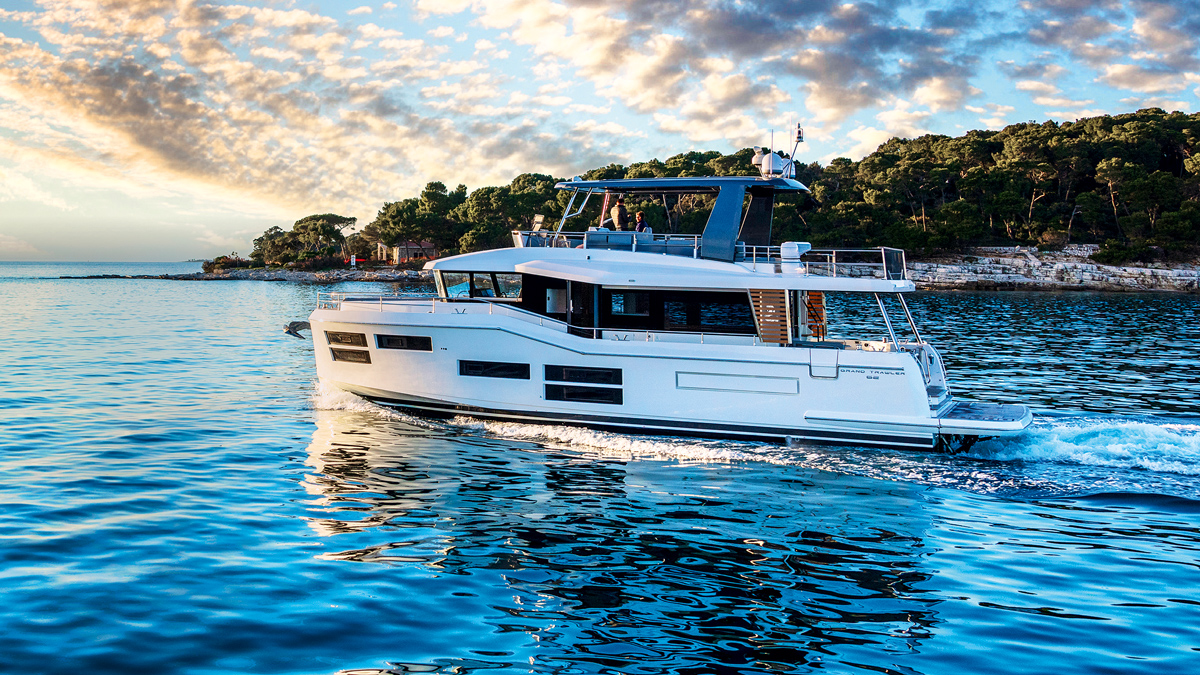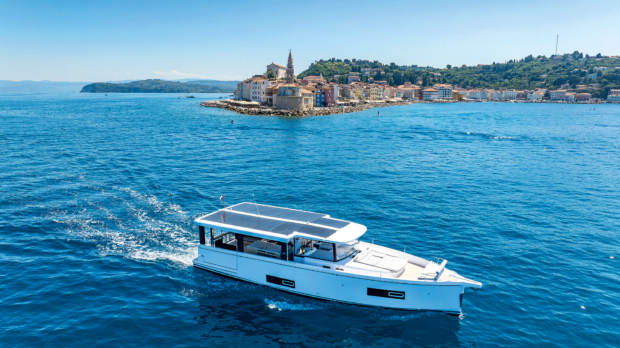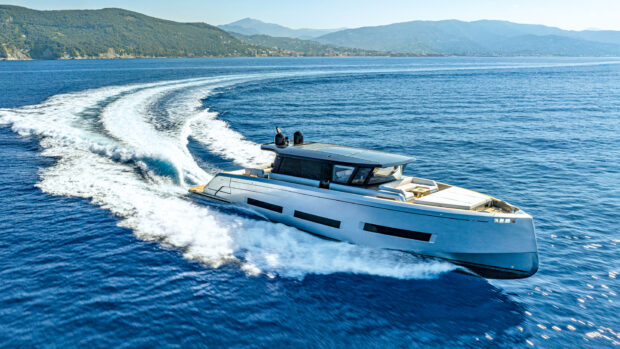The Beneteau Grand Trawler 62 is the new flagship of Beneteau’s trawler range, but is this voluminous fast-displacement cruiser the brand’s first true passagemaker?
The scheduling at the Cannes Boat Show was so insanely tight that I was an untied deck shoe away from missing my appointment to sea trial the Beneteau Grand Trawler 62 at the show.
In fact, if a harbour master hadn’t taken pity on me and chased the big Beneteau down with me perched on the bow of his little RIB the test may never have happened.
Approaching the Beneteau Grand Trawler 62 from the stern at water level is quite a way to be introduced to it, as it is a huge boat.
It is the largest boat that Beneteau (the brand, not the group) has ever built and it certainly has a presence. It’s more than 60ft long and nearly 18ft wide, towering above me from my vantage point on the waterline.
Having clambered onto the bathing platform to join the Beneteau crew and 10 or so other journalists on board for the trial, it’s striking how different this flagship feels to the Swift Trawler range.
The Beneteau Grand Trawler 62 shares many of the same design principles as the smaller trawler yachts that Beneteau produces but it has an eye on finesse a cut above its more utilitarian siblings. It is, after all, built at Beneteau Group’s Italian Monfalcone plant where the Monte Carlo Yachts range is made.
Article continues below…

How superyachts are built: Behind the scenes at Monte Carlo Yachts

Nordhavn 63 yacht tour: You can cross the Atlantic in this go-anywhere boat
The glass transom makes the cockpit feel very open and connects the aft end of the deck to the large hydraulic bathing platform, which has a lift capacity of 400kg.
There is a crane option for the flybridge (with the same lift capacity) so the tender can be kept there if preferred, but with hi-lo functionality and pop-up chocks built into the deck, the platform would be the most convenient place to stow the tender.
Detailing is impressive here, like the steps that are built into the platform which deploy as it’s lowered into the water, and the full width, teak-laid lip at the bottom of the transom which both acts as an aft-facing perch but also allows you to cross the transom without getting wet feet when the platform is down.
The majority of these boats will be owner-run and the crew space has been arranged with that in mind. It works very well if there are crew on board but the configuration makes it a genuinely useful space without crew.
It’s packed with storage and is home to the washing machine. The toilet and shower compartments are split, with the toilet as close to the entrance as possible, so those who have just emerged from the water can use facilities without getting the main interior wet.
Similarly, if guests want more than just a quick wash off from the deck shower there is a shower compartment that they can use without the need to head to the lower deck.
Practical details
There is also access to the impressive machinery space from here, as well as through a hatch that leads down from the cockpit for quick checks. The big trawler yacht certainly hasn’t forgotten its roots and is as practical as they come.
Storage, both on deck and throughout the cabins, is superb and there are lots of clever ideas that make the day-to-day running of the boat a bit easier.
All of the filler caps for the fuel, water and waste tanks are housed behind separate hatches at knee level on the starboard side deck to protect the teak from spillages, and there is an external access hatch for the galley bin so you can drag bin bags straight on to deck and not through the saloon.

Side doors on both decks create excellent pathways through the boat and boost natural ventilation inside
The foredeck sun pads are flanked by two deep lockers, the ideal dimensions for swallowing lines and a couple of fenders.
Possibly the most useful addition of all is the internal staircase that links the saloon to the flybridge, a feature that so enhances the workings of the boat but one that very few designers incorporate any more.
The Beneteau Grand Trawler 62 has the feel of something that has been designed to be at sea for weeks on end and it’s telling that a lot of these practical design features were informed by feedback from existing Swift Trawler owners.
These owners may live on board for an entire season, so things like having easy access to the storage under the berths and a well-shaped, seagoing galley with domestic refrigeration are key considerations.
The layout of the saloon suits that passagemaking ethos, with the galley just forward of amidships and close enough to the lower helm that those on watch can safely pop into it to grab a drink or make a quick snack.
It’s directly opposite the internal dinette, which features a table on a sliding mechanism so you can push it against the sofa, which both creates more space in the companionway and reveals a useful handhold for steadying yourself at sea.
The dinette sofa only runs down one side of the table but the boat comes with four super slender director’s chairs, which can be arranged around the table to boost dining space and all stow away beneath the dinette bench when not in use.
Access in and out of the saloon is excellent thanks to side doors on both sides of the boat, the sliding doors aft and the aforementioned internal stairs to the top deck. We had a lot of people on board but I never struggled to find a clear path in and out of the saloon.
As standard, the lower deck is fitted with three cabins all with their own ensuite bathrooms – a great layout for those who will cruise alone the majority of the time but want the space to host guests in comfort.

The amidships owner’s suite is spacious, bright and packed with intelligent storage solutions throughout
Having three separate bathrooms means guests have plenty of privacy and if the twin cabin feels formulaic in its arrangement the same can’t be said for the VIP with its angled, walkaround double bed.
The owner’s suite is amidships and is just brimming with storage and, like the rest of the interior, boasts at least 6ft 6in of headroom.
Standing tall
The boat’s height, so beneficial in providing ample internal volume, is felt at sea. Granted, we had a lot of people on board, most of whom were huddled on the flybridge scribbling down notes, but the combination of the round-bilge hull shape and a few hundred kilograms of hardtop give the Beneteau Grand Trawler 62 a propensity to wallow in the lower reaches of the rev range.

The ability to cruise long distances in comfort is a far more relaxing proposition than hammering around at 25 knots
For this reason, the Quick gyroscopic stabiliser is pretty much a necessity – even at €94,000 – but given this hull is optimised to run at 8-10 knots the benefit will be felt when cruising and not just when the boat is at anchor.
This MICAD displacement hull with a round bilge and vertical stem is quite a departure from the Beneteau trawler norm. The other trawler yachts with their classic semi-displacement hulls feel happiest cruising in the mid to low teens whereas the Beneteau Grand Trawler 62 was designed with sub 10-knot cruising in mind.
The pace may be slow but the benefit is impressive cruising range, thanks to a total fuel capacity just shy of 4,000 litres. The goal that Beneteau worked towards was 1,000nm at 9 knots and the data we captured on test suggests this is right on the money.
At 8.5 knots with all those bodies on board, 40% fuel and 15% water the twin MAN 730s were sipping a combined 24 litres per hour for a range of 1,084nm with 20% in reserve.
At this speed the hull slips through the water with grace, gently shoving the waves aside and plodding on resolutely.
Sound levels are well contained and with deck spaces that have so much to offer it means those on board can make the most of them without being bombarded by throttle-induced breeze.
It won’t always be convenient to travel at such a measured pace, though, and the oomph of those 730hp MANs will be welcome when trying to outrun bad weather.
Flat out the boat will hit 20 knots, but be prepared for fuel consumption to rocket at the same pace as range plummets.
At full revs the engines will devour all 3,870 litres of diesel after just 285 miles. Stick to that single-figure sweetspot, keep the stabiliser spooled up and life aboard the Beneteau Grand Trawler 62 is rewarding in its serenity.
In hard turns you can feel the boat’s weight even with the gyro doing its thing, but the boat does turn back on itself neatly without the lethargic attitude that you often find with displacement craft.
To give Beneteau credit, both helm stations have been arranged with ergonomics of hand-steering in mind. The relationship between wheel, seat and throttles is good and with triple Raymarine MFDs on both dashboards it’s easy to customise the information that is being relayed to the skipper.
The joystick, which combines both shafts and the thruster, is a €37,000 option and one that can probably be left unticked given the excellent control provided by the throttles and potent proportional Sleipner thrusters.
Lofty credentials
Despite the number of boats that had escaped the confines of the show for sea trials at the same time as us and the amount of wash thrashing about there was very little to test the mettle of the Beneteau Grand Trawler 62’s hull.
That said, anything that did come our way was dismissed with little fuss and perched atop the flybridge with a view over that purposeful foredeck and nearly 30 tonnes of boat beneath you, it feels like it would take quite a sea to knock this thing off course.
There will be trawler purists out there wringing their hands at the notion that this boat could be mentioned in the same company as “true” displacement trawlers, but that really isn’t the way to look at this boat.
It’s not trying to compete with Fleming or Nordhavn but has in its sights a customer who has come to the realisation that speed and top-end performance are of no real interest on a boat of this size.
That living space, practicality and the ability to cruise long distances in comfort without having to worry about the next fuel stop can be a far more relaxing proposition than hammering around at 25 knots.
Then there’s the price. The Beneteau Grand Trawler 62 doesn’t feel like a Fleming or a Grand Banks because it’s a hell of a lot cheaper than those boats.
Two million euros (without VAT) is a serious chunk of change, but for a well specified boat of this size that has such impressive long-range cruising ability it feels like relatively good value for money.
Price as reviewed:
£2,000,000.00 ex. VAT
Verdict
This smash-and-grab sea trial provided good insight into where Beneteau wants to go with the trawler range but I couldn’t help thinking that a short trip around the bay couldn’t unearth the best from the Beneteau Grand Trawler 62. We have plans to conduct a more in-depth test early next year when hopefully, in less pressured circumstances, we will be able to experience its promising cruising credentials first hand. Watch this space...
Details
Starting price: £1,380,000 (ex. VAT)
LOA: 62ft 2in (18.95m)
Beam: 17ft 9in (5.41m)
Draught: 4ft 7in (1.4m)
Displacement: 28.5 tonnes
Fuel capacity: 3,870 litres
Water capacity: 840 litres
Test engines: Twin 730hp MAN i6 diesels
Top speed on test: 20.5 knots
Noise: 79dB(A)
Cruising speed: 9.9 knots
Fuel consumption: 42lph
Range: 730nm
RCD category: B for 16 people
Design: MICAD / Nauta





